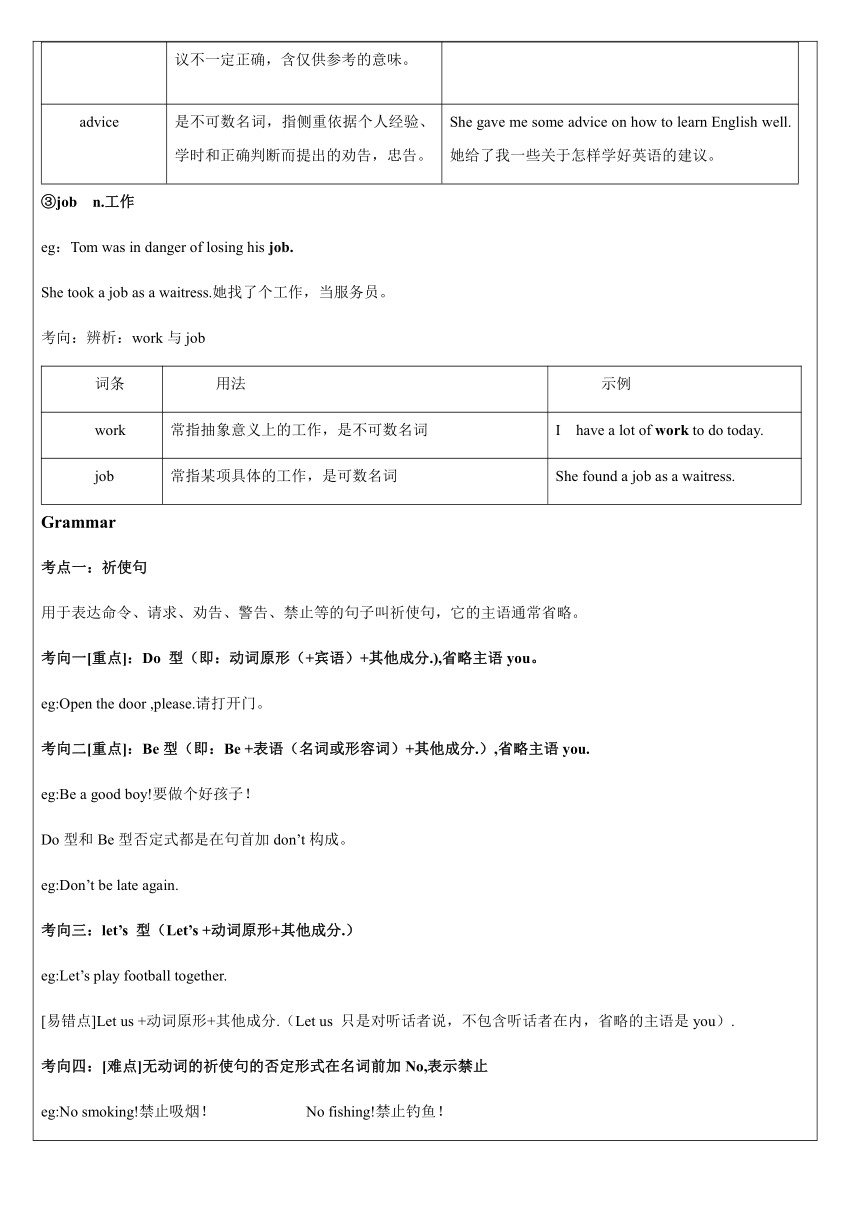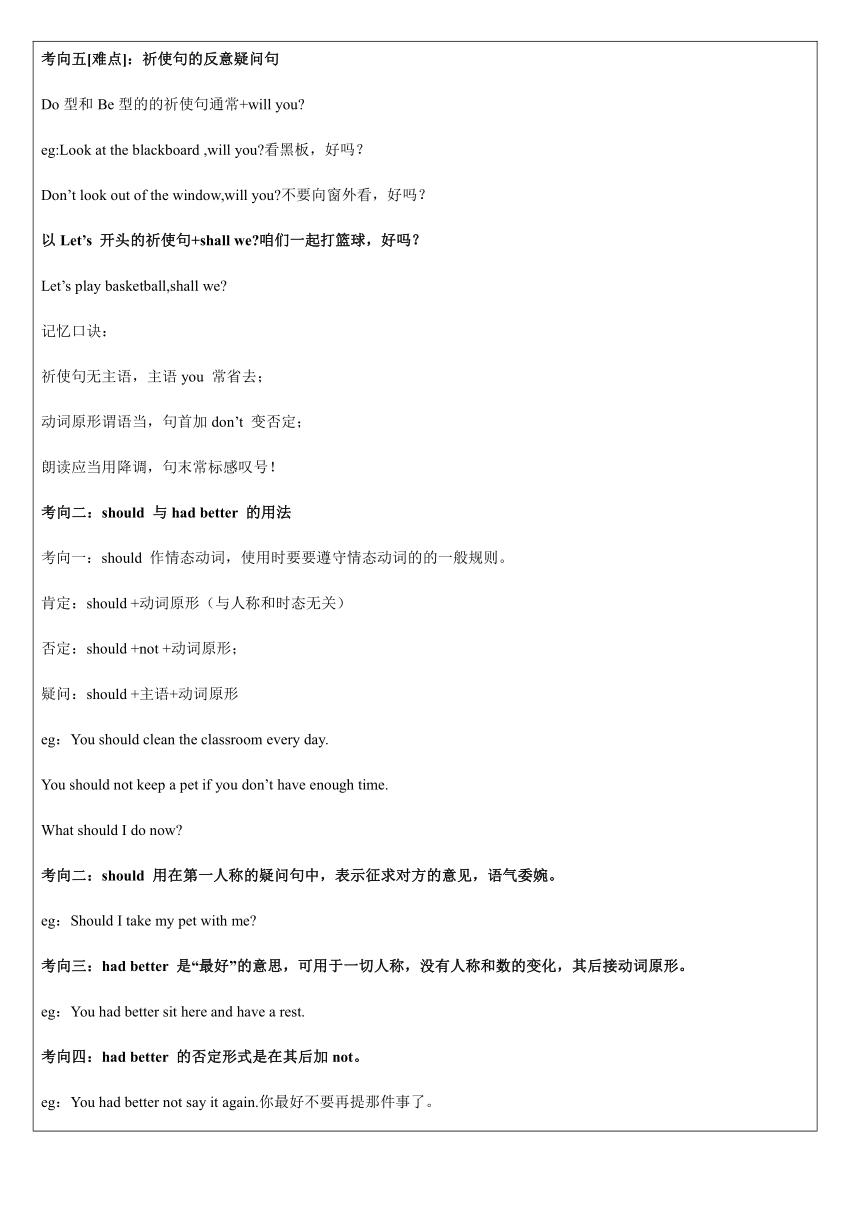Unit 4 Do it yourself Grammar 讲义 2024-2025学年牛津译林版八年级英语上册
文档属性
| 名称 | Unit 4 Do it yourself Grammar 讲义 2024-2025学年牛津译林版八年级英语上册 |  | |
| 格式 | docx | ||
| 文件大小 | 24.8KB | ||
| 资源类型 | 教案 | ||
| 版本资源 | 牛津译林版 | ||
| 科目 | 英语 | ||
| 更新时间 | 2024-06-18 08:34:05 | ||
图片预览



文档简介
教 学 内 容 8A Unit 4 Grammar
教 学 目 标 1. 掌握祈使句的肯定和否定两种形式 2. 牢记祈使句中出现的一些特殊情况。 3 学会用should和had better来提出建议 4. 重点词汇、短语
重 点 1. 祈使句肯定和否定两种形式的应用 2. 祈使句中出现的一些特殊情况及其应用
难 点 熟练运用本部分知识完成相关练习。
教学过程
①cut vt. 剪下,切下,割下 考向:过去式为cut,现在分词为cutting。搭配:cut out 剪出,cut down砍倒,cut up 切碎 eg:Cut up the meat.把肉切碎。 Don’t cut them down.别把它们砍倒。 【测一测】 Our country is taking action to air pollution. A. cut down B. cut up C. cut out D. cut off ②advice n. 建议,忠告,劝告 考向一:advice 为不可数名词,表达“一条建议”用“a piece of advice”. eg;Here are some pieces of advice for you .这是给你的几条建议。 考向二:表示“在某方面提供建议”时,常与介词on 搭配。 eg:Please give us some advice on how to save money. 考向三:辨析:suggestion与advice 词条含义及用法示例suggestion是可数名词,指为改进工作、解决困难等提出的“建议,提议”,有时所提的建议不一定正确,含仅供参考的意味。What a useful suggestion!多么有用的一条建议啊!advice是不可数名词,指侧重依据个人经验、学时和正确判断而提出的劝告,忠告。She gave me some advice on how to learn English well.她给了我一些关于怎样学好英语的建议。
③job n.工作 eg:Tom was in danger of losing his job. She took a job as a waitress.她找了个工作,当服务员。 考向:辨析:work与job 词条用法示例work常指抽象意义上的工作,是不可数名词I have a lot of work to do today.job常指某项具体的工作,是可数名词She found a job as a waitress.
Grammar 考点一:祈使句 用于表达命令、请求、劝告、警告、禁止等的句子叫祈使句,它的主语通常省略。 考向一[重点]:Do 型(即:动词原形(+宾语)+其他成分.),省略主语you。 eg:Open the door ,please.请打开门。 考向二[重点]:Be型(即:Be +表语(名词或形容词)+其他成分.),省略主语you. eg:Be a good boy!要做个好孩子! Do型和Be型否定式都是在句首加don’t构成。 eg:Don’t be late again. 考向三:let’s 型(Let’s +动词原形+其他成分.) eg:Let’s play football together. [易错点]Let us +动词原形+其他成分.(Let us 只是对听话者说,不包含听话者在内,省略的主语是you). 考向四:[难点]无动词的祈使句的否定形式在名词前加No,表示禁止 eg:No smoking!禁止吸烟! No fishing!禁止钓鱼! 考向五[难点]:祈使句的反意疑问句 Do型和Be型的的祈使句通常+will you eg:Look at the blackboard ,will you 看黑板,好吗? Don’t look out of the window,will you 不要向窗外看,好吗? 以Let’s 开头的祈使句+shall we 咱们一起打篮球,好吗? Let’s play basketball,shall we 记忆口诀: 祈使句无主语,主语you 常省去; 动词原形谓语当,句首加don’t 变否定; 朗读应当用降调,句末常标感叹号! 考向二:should 与had better 的用法 考向一:should 作情态动词,使用时要要遵守情态动词的的一般规则。 肯定:should +动词原形(与人称和时态无关) 否定:should +not +动词原形; 疑问:should +主语+动词原形 eg:You should clean the classroom every day. You should not keep a pet if you don’t have enough time. What should I do now 考向二:should 用在第一人称的疑问句中,表示征求对方的意见,语气委婉。 eg:Should I take my pet with me 考向三:had better 是“最好”的意思,可用于一切人称,没有人称和数的变化,其后接动词原形。 eg:You had better sit here and have a rest. 考向四:had better 的否定形式是在其后加not。 eg:You had better not say it again.你最好不要再提那件事了。 随堂练习 一、单项选择 1. Let's a noise; someone is sleeping. A. not make B. no making C. not to make 2. get off the bus before it stops. A. Don't B. Doesn't C. Didn't D. Not 3. buy your ticket from a ticket machine. Because there are lots of people there. A. Not B. Not to C. Don't D. Don’t to 4.We think more of others if we want to get on well with them. A. should B. needn’t C. may not D. shouldn’t 5. to smile at your life when you are in trouble, and you will soon be happy again. A. Try B. To try C. Trying D. Tried 6.—I’m worried about my English. 一 harder you will catch up with your classmates! A. Working; and B. To work ; or C. Work; and D. Worked; or 7.Please get yourself ready for the next part, A. shall we B. will you C. do you D. are you 8 Please your exam papers once again before handing them in. A. going over B. went over C. go over D. to go over 9 Don’t make so much noise, Lily, A do you B. don’t you C Will you D. doesn’t you 10.—Remember to turn off the lights when you leave the room. A. OK, I will B. Yes, I won’t C. It doesn't matter D. I did 11.Let's go to school together, A. will you B. will we C. shall we D. shall you 二、根据句意,选择方框中的词并用其适当形式填空 paint, draw, write, try, cut 13.Don't on the wall. 14. some new words on the blackboard. 15. to remember this new word. 16.I’d like to the wall blue. 17. out the picture with a pair of scissors. 三、运成句子 18.You shouldn’t be late for class.(改为祈使句) late for class. 19.You should tidy up your bedroom.(改为祈使句) your bedroom. 20.Let us go home.(变反意疑问句) Let us go home, 21.You should play basketball there.(改为否定句) You basketball there. 22.You should get some water with you.(改为一般疑问句) Should I water with me 23.你最好不要单独在河里游泳。(汉译英) You’d better in the river alone.
Period 3:Grammar
1.A
2.A点拨:考查祈使句的用法。祈使句的否定形式为Dont+动词原形,故选A。
3.C
4.A点拨:考查情态动词。句意:如果我们要和别人相处得好,就应该多为他们着想。A应该;B.不必;C.可能不;D.不应该,由句意分析知应选A。
5.A点拨:考查祈使句的用法。祈使句一般以动词原形开头,表示命令、请求等。故选A。
6.C点拨:本题考查祈使句及连词的用法。祈使句以动词原形开头,故用Work;and意为“然后”;or意为“或者”。答语句意“更努力地学习,然后你将赶上你的同班同学们!”。故选C。
7.B点拨:考查祈使句的反意疑问句。Do型和Be型祈使句的反意疑问部分可以用willyou,故选B。
8.C
9.C点拨:考查祈使句的反意疑问句。Do型和Be型祈使句的反意疑问部分通常用“willyou”。
10.A点拨:考查祈使句的回答。祈使句的动作通常是表示将来发生的动作,所以回答时一般用will或won't。根据句意可知选A。
11.C点拨:考查祈使句的反意疑问句。以Let's开头的祈使句,反意疑问部分用 shallwe,故选C
12.C点拨: No photos意为“禁止拍照”。故选C。
二、13.draw
14. Write
15 Try
16 paint
17.Cut
三、18.Don'tbe点拨:本题用转化法。由句意可知改为否定的祈使句,故填Don'tbe
19. Tidy up点拨:本题用转化法。由句意可知改为肯定的祈使句,肯定的祈使句一般用动词原形开头。
20. will you
21. shouldn't play
22. get any
23. not swim
教 学 目 标 1. 掌握祈使句的肯定和否定两种形式 2. 牢记祈使句中出现的一些特殊情况。 3 学会用should和had better来提出建议 4. 重点词汇、短语
重 点 1. 祈使句肯定和否定两种形式的应用 2. 祈使句中出现的一些特殊情况及其应用
难 点 熟练运用本部分知识完成相关练习。
教学过程
①cut vt. 剪下,切下,割下 考向:过去式为cut,现在分词为cutting。搭配:cut out 剪出,cut down砍倒,cut up 切碎 eg:Cut up the meat.把肉切碎。 Don’t cut them down.别把它们砍倒。 【测一测】 Our country is taking action to air pollution. A. cut down B. cut up C. cut out D. cut off ②advice n. 建议,忠告,劝告 考向一:advice 为不可数名词,表达“一条建议”用“a piece of advice”. eg;Here are some pieces of advice for you .这是给你的几条建议。 考向二:表示“在某方面提供建议”时,常与介词on 搭配。 eg:Please give us some advice on how to save money. 考向三:辨析:suggestion与advice 词条含义及用法示例suggestion是可数名词,指为改进工作、解决困难等提出的“建议,提议”,有时所提的建议不一定正确,含仅供参考的意味。What a useful suggestion!多么有用的一条建议啊!advice是不可数名词,指侧重依据个人经验、学时和正确判断而提出的劝告,忠告。She gave me some advice on how to learn English well.她给了我一些关于怎样学好英语的建议。
③job n.工作 eg:Tom was in danger of losing his job. She took a job as a waitress.她找了个工作,当服务员。 考向:辨析:work与job 词条用法示例work常指抽象意义上的工作,是不可数名词I have a lot of work to do today.job常指某项具体的工作,是可数名词She found a job as a waitress.
Grammar 考点一:祈使句 用于表达命令、请求、劝告、警告、禁止等的句子叫祈使句,它的主语通常省略。 考向一[重点]:Do 型(即:动词原形(+宾语)+其他成分.),省略主语you。 eg:Open the door ,please.请打开门。 考向二[重点]:Be型(即:Be +表语(名词或形容词)+其他成分.),省略主语you. eg:Be a good boy!要做个好孩子! Do型和Be型否定式都是在句首加don’t构成。 eg:Don’t be late again. 考向三:let’s 型(Let’s +动词原形+其他成分.) eg:Let’s play football together. [易错点]Let us +动词原形+其他成分.(Let us 只是对听话者说,不包含听话者在内,省略的主语是you). 考向四:[难点]无动词的祈使句的否定形式在名词前加No,表示禁止 eg:No smoking!禁止吸烟! No fishing!禁止钓鱼! 考向五[难点]:祈使句的反意疑问句 Do型和Be型的的祈使句通常+will you eg:Look at the blackboard ,will you 看黑板,好吗? Don’t look out of the window,will you 不要向窗外看,好吗? 以Let’s 开头的祈使句+shall we 咱们一起打篮球,好吗? Let’s play basketball,shall we 记忆口诀: 祈使句无主语,主语you 常省去; 动词原形谓语当,句首加don’t 变否定; 朗读应当用降调,句末常标感叹号! 考向二:should 与had better 的用法 考向一:should 作情态动词,使用时要要遵守情态动词的的一般规则。 肯定:should +动词原形(与人称和时态无关) 否定:should +not +动词原形; 疑问:should +主语+动词原形 eg:You should clean the classroom every day. You should not keep a pet if you don’t have enough time. What should I do now 考向二:should 用在第一人称的疑问句中,表示征求对方的意见,语气委婉。 eg:Should I take my pet with me 考向三:had better 是“最好”的意思,可用于一切人称,没有人称和数的变化,其后接动词原形。 eg:You had better sit here and have a rest. 考向四:had better 的否定形式是在其后加not。 eg:You had better not say it again.你最好不要再提那件事了。 随堂练习 一、单项选择 1. Let's a noise; someone is sleeping. A. not make B. no making C. not to make 2. get off the bus before it stops. A. Don't B. Doesn't C. Didn't D. Not 3. buy your ticket from a ticket machine. Because there are lots of people there. A. Not B. Not to C. Don't D. Don’t to 4.We think more of others if we want to get on well with them. A. should B. needn’t C. may not D. shouldn’t 5. to smile at your life when you are in trouble, and you will soon be happy again. A. Try B. To try C. Trying D. Tried 6.—I’m worried about my English. 一 harder you will catch up with your classmates! A. Working; and B. To work ; or C. Work; and D. Worked; or 7.Please get yourself ready for the next part, A. shall we B. will you C. do you D. are you 8 Please your exam papers once again before handing them in. A. going over B. went over C. go over D. to go over 9 Don’t make so much noise, Lily, A do you B. don’t you C Will you D. doesn’t you 10.—Remember to turn off the lights when you leave the room. A. OK, I will B. Yes, I won’t C. It doesn't matter D. I did 11.Let's go to school together, A. will you B. will we C. shall we D. shall you 二、根据句意,选择方框中的词并用其适当形式填空 paint, draw, write, try, cut 13.Don't on the wall. 14. some new words on the blackboard. 15. to remember this new word. 16.I’d like to the wall blue. 17. out the picture with a pair of scissors. 三、运成句子 18.You shouldn’t be late for class.(改为祈使句) late for class. 19.You should tidy up your bedroom.(改为祈使句) your bedroom. 20.Let us go home.(变反意疑问句) Let us go home, 21.You should play basketball there.(改为否定句) You basketball there. 22.You should get some water with you.(改为一般疑问句) Should I water with me 23.你最好不要单独在河里游泳。(汉译英) You’d better in the river alone.
Period 3:Grammar
1.A
2.A点拨:考查祈使句的用法。祈使句的否定形式为Dont+动词原形,故选A。
3.C
4.A点拨:考查情态动词。句意:如果我们要和别人相处得好,就应该多为他们着想。A应该;B.不必;C.可能不;D.不应该,由句意分析知应选A。
5.A点拨:考查祈使句的用法。祈使句一般以动词原形开头,表示命令、请求等。故选A。
6.C点拨:本题考查祈使句及连词的用法。祈使句以动词原形开头,故用Work;and意为“然后”;or意为“或者”。答语句意“更努力地学习,然后你将赶上你的同班同学们!”。故选C。
7.B点拨:考查祈使句的反意疑问句。Do型和Be型祈使句的反意疑问部分可以用willyou,故选B。
8.C
9.C点拨:考查祈使句的反意疑问句。Do型和Be型祈使句的反意疑问部分通常用“willyou”。
10.A点拨:考查祈使句的回答。祈使句的动作通常是表示将来发生的动作,所以回答时一般用will或won't。根据句意可知选A。
11.C点拨:考查祈使句的反意疑问句。以Let's开头的祈使句,反意疑问部分用 shallwe,故选C
12.C点拨: No photos意为“禁止拍照”。故选C。
二、13.draw
14. Write
15 Try
16 paint
17.Cut
三、18.Don'tbe点拨:本题用转化法。由句意可知改为否定的祈使句,故填Don'tbe
19. Tidy up点拨:本题用转化法。由句意可知改为肯定的祈使句,肯定的祈使句一般用动词原形开头。
20. will you
21. shouldn't play
22. get any
23. not swim
